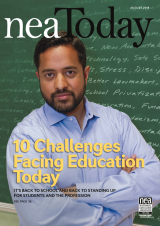
Whether you’re a classroom teacher, school counselor, paraeducator, bus driver, cafeteria worker or school secretary, everyone who works in a public school faces a new school year ready to do the job they love. But they are also prepared to confront undeniable challenges. These challenges may differ district to district, school to school, but one thing is clear: the voice of educators is needed now more than ever and their unions are providing the megaphone. It’s not up to our teachers and school staff to shoulder this burden themselves. Administrators, parents, communities, lawmakers must do their part. But as the mobilization of educators that began earlier this year has demonstrated so powerfully - the “Educator Spring” as former NEA President Lily Eskelsen García calls it - the nation is finally listening to what they have to say.
Education Funding: Where's the Money?
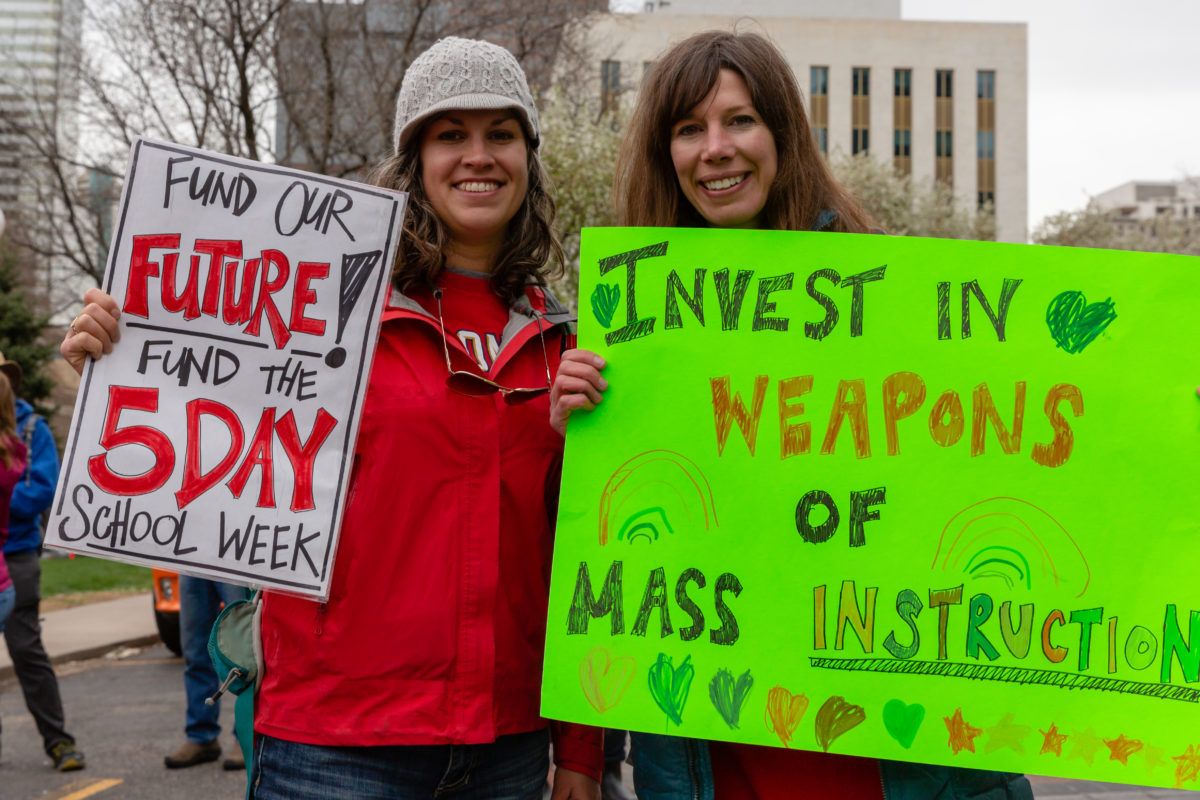
When educators from around the country walked out of their classrooms last spring, their message was clear: Our students deserve better. By taking this action, they said no more jam-packed classrooms with 40-plus desks, no more decades-old textbooks held together with rubber bands, and no more leaky ceilings, broken light fixtures, pest infestations, and cuts to basic curricula that are essential to a well-rounded education.
“We are truly in a state of crisis,” says Noah Karvelis, an educator from Arizona, where cuts to public school funding have been deeper than anywhere else in the country.
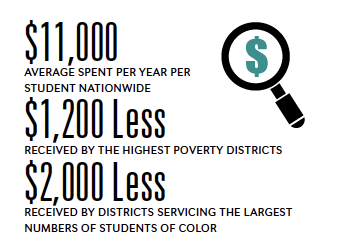 Public school funding has been cut to the quick all over the country after excessive and reckless tax cuts.
Public school funding has been cut to the quick all over the country after excessive and reckless tax cuts.
It’s been more than 10 years since the Great Recession, but many states are providing far less money to their schools today than they did before the crash. Our schools are crumbling and educators are leaving the profession in droves, unable to pay off student debt or make ends meet on stagnant salaries.
As of the 2017 – 2018 school year, at least 12 states had slashed “general” or “formula” funding—the primary form of state support for elementary and secondary schools—by 7 percent or more per student over the last decade, according to the Center on Budget and Policy Priorities. Seven of the states—Arizona, Idaho, Kansas, Michigan, Mississippi, North Carolina, and Oklahoma—enacted tax cuts costing tens or hundreds of millions of dollars each year, instead of restoring education funding.
“To add to this heartache, new teachers in our state of North Carolina have never known anything different, and many even believe our current reality is normal,” says Todd Warren, a Spanish teacher and president of North Carolina’s Guilford County Association of Educators. “While the wealthy and corporate elite recovered from the recession of 2008, public school teachers and their students did not. North Carolina public school teachers make more than 11 percent less on average than we did 15 years ago when salaries are adjusted for inflation.”
But it’s the students who suffer the most from budget cuts, particularly poor students. Public education has been a pathway out of poverty for families for generations, but that pathway is blocked when schools are unable to offer a decent education.Too often, low-income students end up in schools with the lowest funding, fewest supplies, the least rigorous curriculum, and the oldest facilities and equipment, according to the U.S. Commission on Civil Rights.
On average, school districts spend around $11,000 per student each year, but the highest-poverty districts receive an average of $1,200 less per child than the least-poor districts, while districts serving the largest numbers of students of color get about $2,000 less than those serving the fewest students of color, the study says.
No more, says Todd Warren.
“There are enough of us to say, ‘Enough!’” says Warren. “It is time to leverage our power now.”
Join millions of voices fighting for our nation's public school students and educators. Take the #RedforEd Pledge!
Keeping School Safe
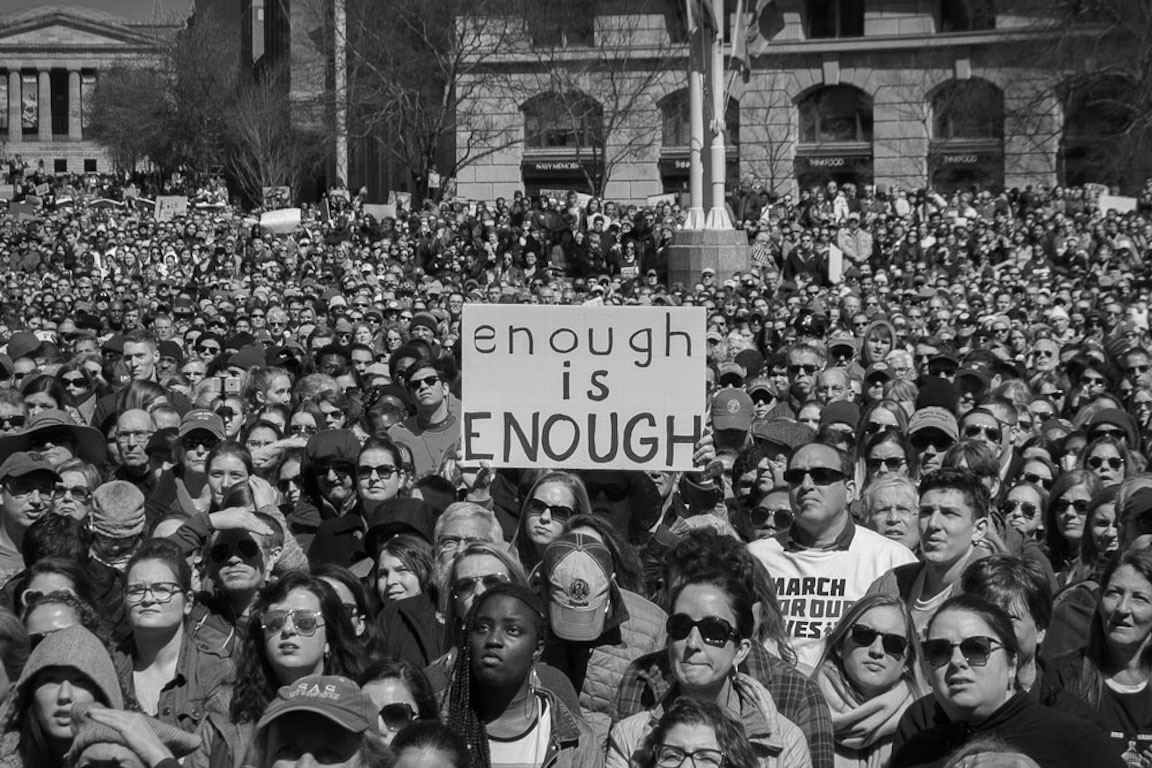
A 2018 survey by the Pew Research Center conducted two months after this year’s February school shooting in Parkland, Fla., showed that 57 percent of U.S. teenagers are worried that a shooting could take place at their own school. One in four are “very worried” about the chance.
Those numbers are staggering but hardly surprising given the rash of school shootings that have captured headlines this year, and in previous years. Since the shooting at Colorado’s Columbine High School in April 1999, more than 187,000 U.S. students have been exposed to gun violence in school.
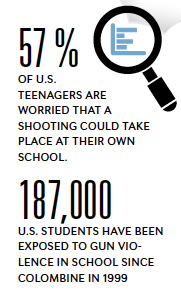 Fed up with lawmakers’ inaction, students across the nation in 2018 are leading a national movement to bring common sense to the discussion.
Fed up with lawmakers’ inaction, students across the nation in 2018 are leading a national movement to bring common sense to the discussion.
Educators understand if students don’t feel safe at school, achievement suffers. It’s the paramount duty of everyone in the community–and the politicians who represent them–to help create safe learning spaces.
Arming teachers and school staff is not the answer. According to an NEA survey, seven in 10 educators said arming school personnel would be ineffective at preventing gun violence in schools and two-thirds said they would feel less safe if school personnel were armed.
Educators across the U.S. stood up to reject the idea that more weapons would help save student lives. As of May 2017, only one state had passed a law that mandated arming teachers and staff.
“We don’t want to be armed. We want better services for our students,” says Corinne McComb, an elementary educator from Norwich, Conn. “More psychologists and counselors who can be present for the students more than one day a week or month. We need services for families. We have the money, we can do this.”
The Pressure is On
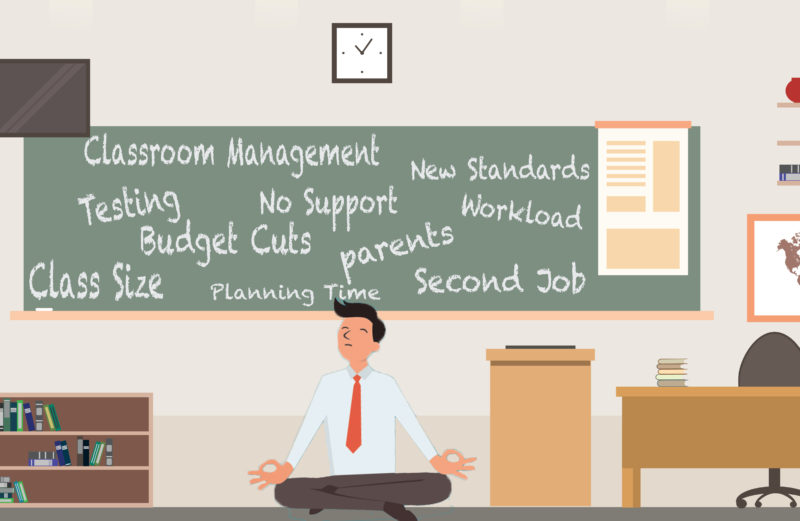
Kathy Reamy, a school counselor at La Plata High School in La Plata, Md., says the trend is unmistakable.
“Honestly, I’ve had more students this year hospitalized for anxiety, depression, and other mental-health issues than ever,” says Reamy, who also chairs the NEA School Counselor Caucus. “There’s just so much going on in this day and age, the pressures to fit in, the pressure to achieve, the pressure of social media.”
It doesn’t help, adds Denise Pope of Stanford University, that schools have become “a pressure cooker for students and staff…and student and teacher stress feed off each other.”
According to a 2018 study by the University of Missouri, 93 percent of elementary school teachers report they are “highly stressed.”
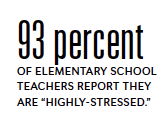 Stressful schools aren’t healthy for anyone. There’s nothing wrong with a little pressure, a little nervousness over an exam, or a teacher who wants students to succeed. We all feel pressure, but something else is going on.
Stressful schools aren’t healthy for anyone. There’s nothing wrong with a little pressure, a little nervousness over an exam, or a teacher who wants students to succeed. We all feel pressure, but something else is going on.
The causes and convergence of teacher and student stress has been a growing concern over the past decade. Research has consistently shown that stress levels in newer educators especially is leading many of them to exit the profession within five years.
Teachers need adequate resources and support in their jobs in order to battle burnout and alleviate stress in the classroom. If we do not support teachers, we risk the collateral damage of students.
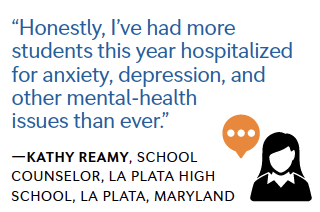 One solution for students could be more one-on-one time with psychologists and counselors. But that’s a challenge since so many of those positions have been cut and are not coming back. That said, more and more schools take the issue of stress seriously, and have begun to look at ways to change policies over homework, class schedules, and later school start times to help alleviate the pressure many students feel.
One solution for students could be more one-on-one time with psychologists and counselors. But that’s a challenge since so many of those positions have been cut and are not coming back. That said, more and more schools take the issue of stress seriously, and have begun to look at ways to change policies over homework, class schedules, and later school start times to help alleviate the pressure many students feel.
“People are finally seeing what negative stress does to the body, what that does to the psyche, and what it does to school engagement,” says Pope. “Schools and communities know stress is a problem and they want solutions.”
A Better Way Forward on Discipline
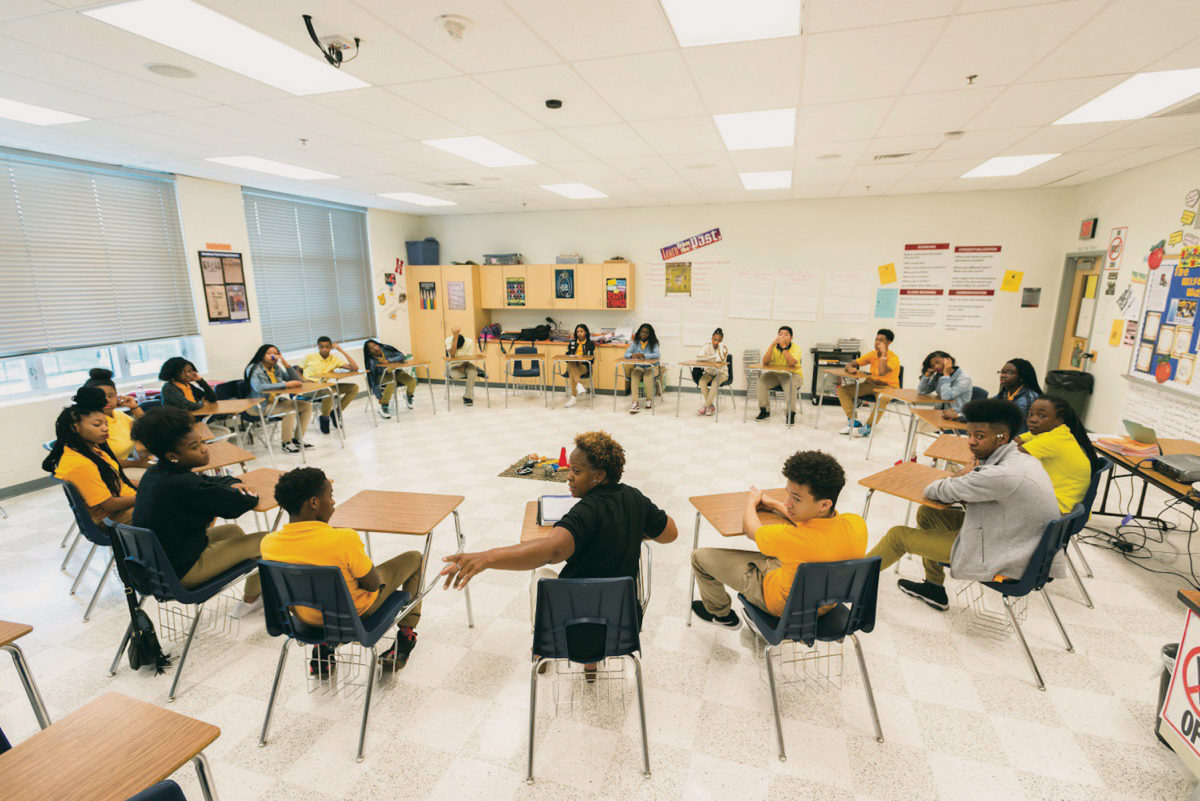
Think back on the days when you were in middle school and high school. Remember the awkwardness, anxiety, and angst that hung over you like a cloud? Your students, no matter their behavior, are probably grappling with the same troubling emotions, says Robin McNair, the Restorative Practices Program coordinator for Prince George’s County in Maryland.
“When you look beyond behavior, when you truly look at the person behind the behavior, you’ll often find a cry for help,” says McNair, whose work in Restorative Justice Practices (RJP) aims to drastically reduce suspensions and expulsions, increase graduation rates, and transform student behaviors.
RJP has proven to be the most effective way for educators to break the school-to-prison pipeline, a national trend where children—mostly low-income and children of color—are funneled out of public schools and into the juvenile and criminal justice systems through harsh “zero tolerance” discipline policies for even minor infractions.
In the 2013 – 2014 school year, the most recent nationwide data available, black students were three times more likely to receive both in-school and out-of-school suspensions than white students.
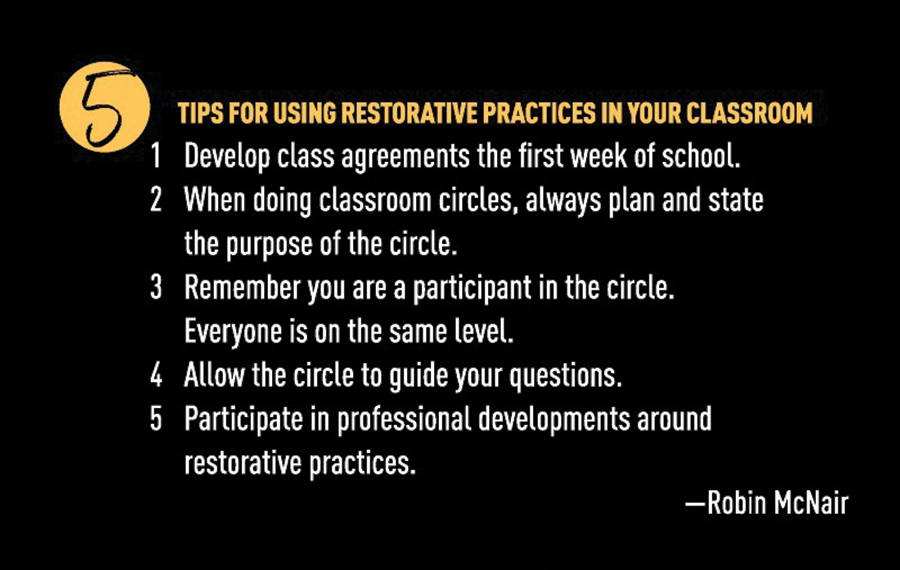
Rather than casting out students after wrongdoing, RJP seeks to reintegrate them into the classroom or school community to make amends and learn how to handle problems more positively.
Simply put, students are better off in school than they are when they’re kicked out and left to their own devices in an empty home or apartment, where court involvement becomes more likely. But all students who participate in RJP—even those not directly involved in a conflict—report feeling safer and happier.
McNair suggests that educators strive to create a tight-knit community, even a family, in their classrooms from day one so that students not only know each other, but genuinely care about each other.
“Restorative practices aren’t only for use after a conflict or incident. These practices allow us to proactively build community within a classroom and within a school by nurturing relationships between teachers and students,” McNair says. “When students know that you care about them they are more likely to follow the rules and more likely to stay in the classroom and do the work,” adds McNair.
Learn more about restorative practices in schools.
Chronic Absenteeism
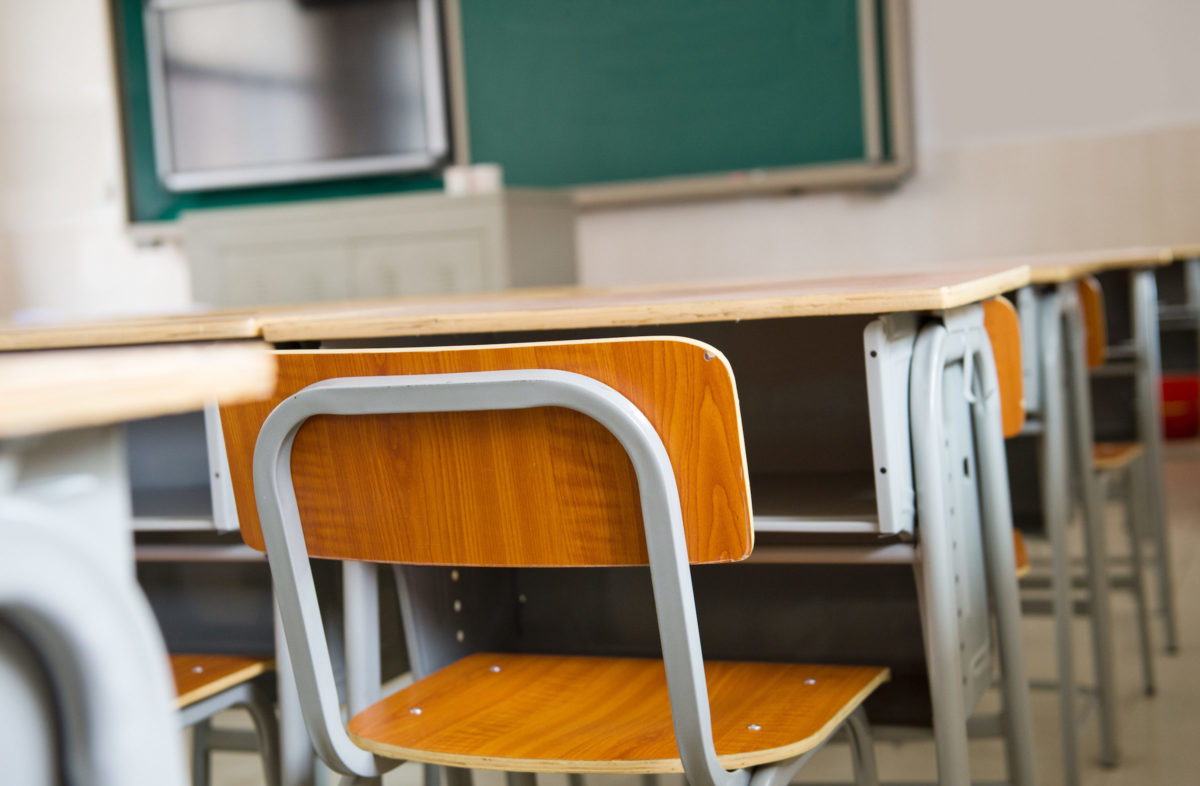
According to the U.S. Department of Education Civil Rights Data Collection (CRDC), about 8 million students missed more than three weeks of school during the 2015 – 2016 school year, up from 6.8 million the previous year.
Chronic absenteeism is typically defined as missing 10 percent or more of a school year. This translates to roughly 18 days a year, or two days every month. Chronic absenteeism is usually a precursor to dropping out. And dropouts often wind up before the court.
Educators like Lois Yukna have created innovative ideas designed to keep kids in school. Others can learn from what Yukna is doing.
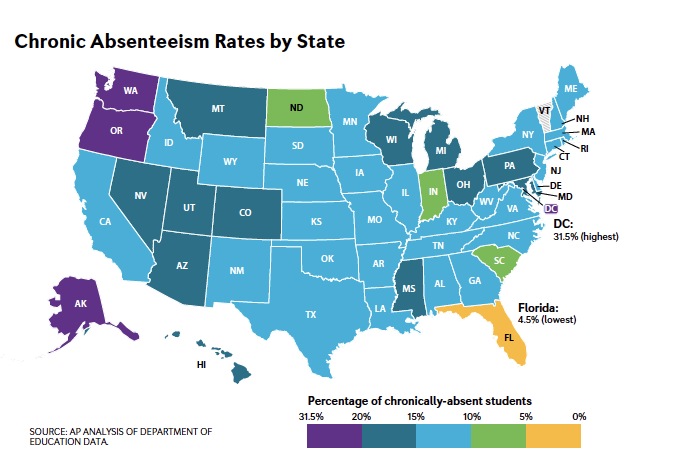
For more decades, Yukna was a school bus driver in Middlesex County, N.J. Today, Yukna is a school attendance officer in New Jersey’s Woodbridge Township School District. Her job now is to make sure that once students get to school, they stay.
When students don’t attend school regularly, Yukna works closely with students, parents, and the courts to turn the situation around.
“Something needed to be done because the main goal is to educate students, and they can’t be educated if they’re not in school,” says Yukna.
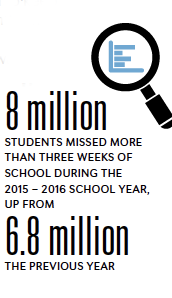 She noticed that students who were frequent no-shows at school were the same ones whose behavior when they attended resulted in detentions, suspensions, and sometimes, trouble with police.
She noticed that students who were frequent no-shows at school were the same ones whose behavior when they attended resulted in detentions, suspensions, and sometimes, trouble with police.
Yukna and a guidance counselor in the Woodbridge district put their heads together to come up with something that would emphasize restorative practices instead of suspension and encourage students to return to and stay in school.
Supported by NEA grants, the program exposes about 100 students “to a world of possibilities through internships, mentorships, and achievement incentives.” Parents have classes on nutrition, health, and the impact of social media and family dynamics on learning. “They learn how to motivate their children to come to school and do their best,” Yukna says.
In the first year, approximately 85 percent of the students improved in at least one area: academics, attendance, or attitude. In the second year, all of the students improved in each area. Best of all, of the participants who were seniors, 100 percent graduated in 2017.
—Contributed by Joye Barksdale
Getting in Front of ESSA
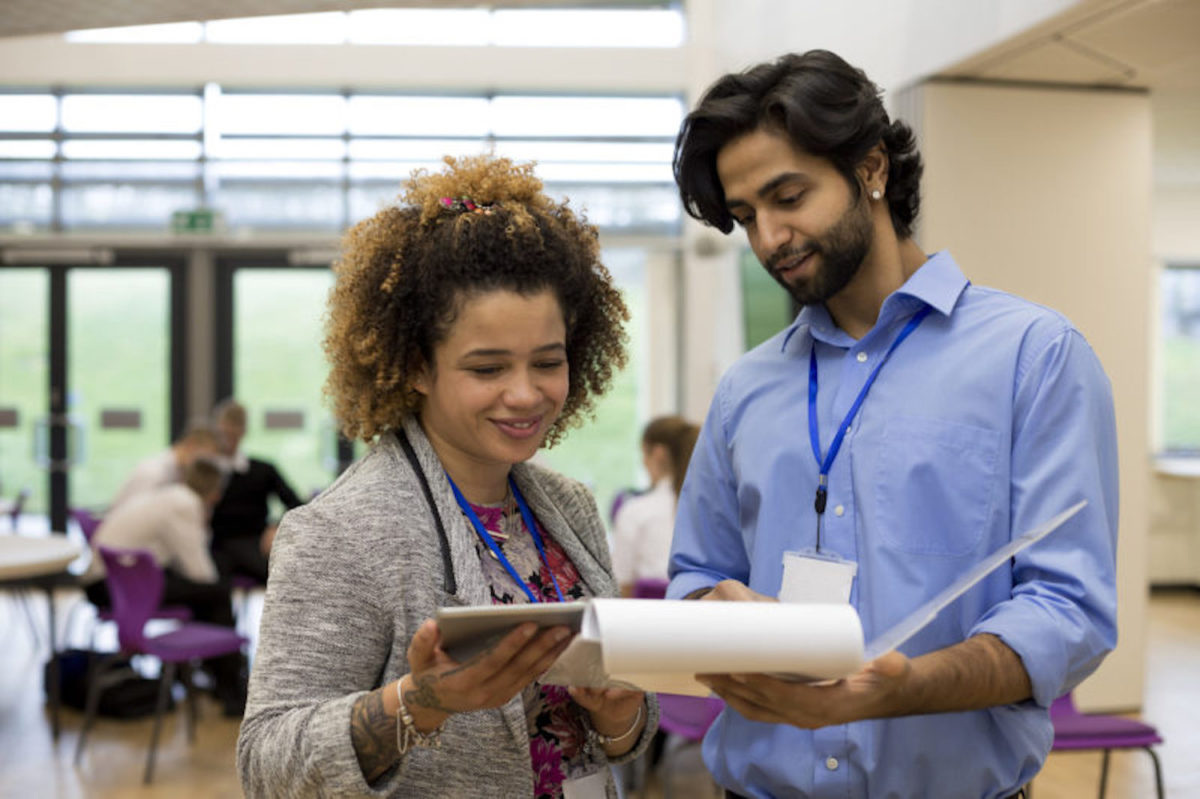
In the last few years, schools and states nationwide have spent a lot of time designing new plans to coincide with the Every Student Succeeds Act (ESSA), passed by Congress in 2016.
Now that ESSA state implementation plans are done, what should educators expect in the new school year?
Expect to see more schools identified for improvement under the law’s expanded accountability system. Some states, like Washington, have already released their list of schools, which were identified through multiple measures of academic and school quality indicators, not just test scores.
The challenge here is that while the accountability system was expanded, the money to help support the additional schools identified for improvement was not. These schools will be put on tiers of support. The greatest amount of money will go to the highest priority and trickle down.
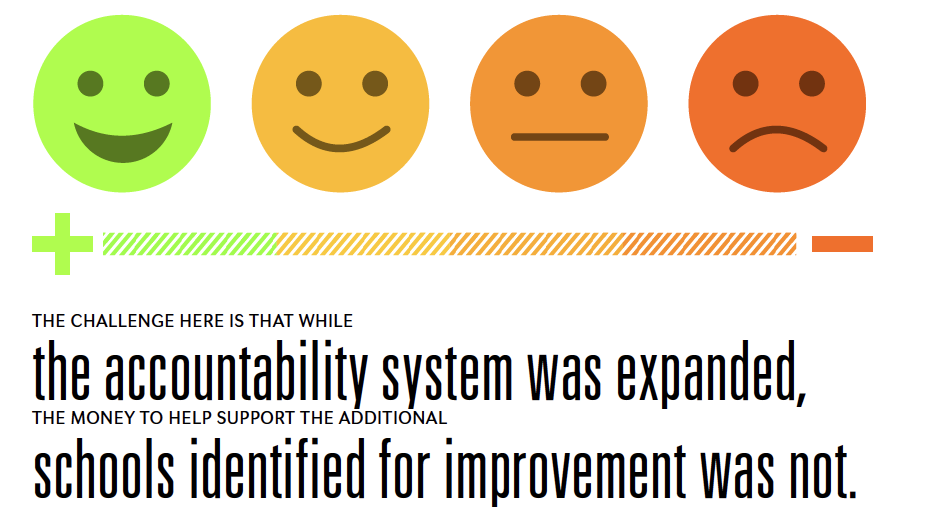
As the school year continues, district leaders will need to create ESSA implementation plans, leaving schools identified for improvement with the task of building their own site-based plans. Since the plans must include educator input—not only teachers, but also paraeducators, nurses, librarians, counselors, and other education support professionals—this is the period during which the voices of NEA members will be critical.
“Get in front of it,” recommends Donna Harris-Aikens, director of NEA’s Education Policy and Practice department. “It is possible that the principal or superintendent in a particular place may not be focused on this yet.”
To learn what’s available at their schools, educators can use NEA’s Opportunity Checklist, a short, criteria-based tool to quickly assess what’s available at their school, and the Opportunity Audit, a tool that is rooted in the seven NEA Great Public Schools (GPS) criteria, which addresses the research and evidence-based resources, policies, and practices that are proven to narrow opportunity and skills gaps.
While some may be discouraged by the thought of placing more schools on an improvement plan, the truth is that despite some funding challenges, ESSA remains a promising opportunity.
Supporting Undocumented Students
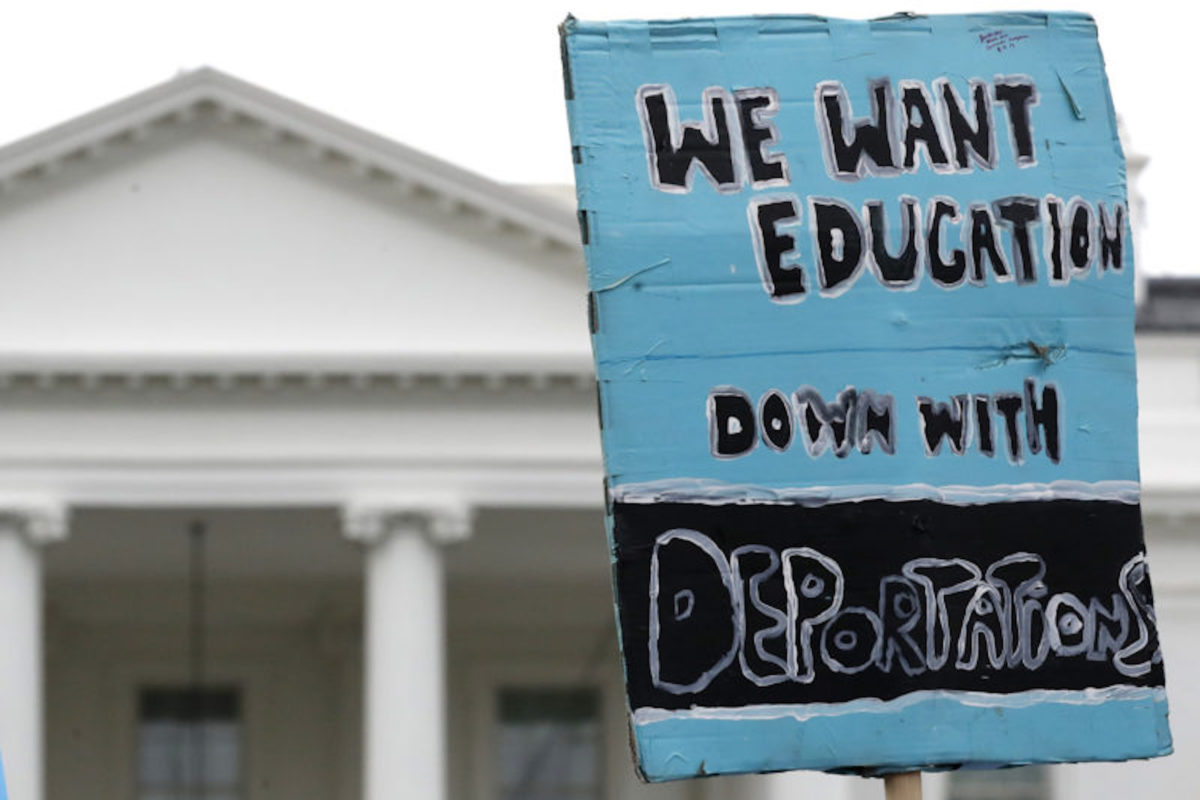 (AP Photo/Jacquelyn Martin)
(AP Photo/Jacquelyn Martin)
If the last several months are any indication of the challenges educators will face around the immigration status of students, they should expect uncertainty and fear.
It’s been an emotional roller coaster for Dreamers—young people brought to the U.S. as children, who have received the Deferred Action for Childhood Arrivals, or DACA, protections over the five years of the program. In September 2017, President Donald Trump rescinded DACA. Five months later, he vowed to work with Congress to protect undocumented immigrants who entered the country illegally as children. In April, he tweeted “DACA is dead” and “NO MORE DACA DEAL.”
“We have a lot of students on hold,” says Hugo Arreola, a campus lab technician for the Phoenix Union High School District in Arizona. A DACA recipient himself, he sees his students and community in turmoil. “Many are afraid to renew their DACA applications, student anxiety is up, and people are still scared. The environment is very tense.”
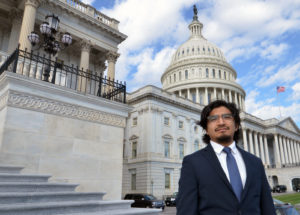 Hugo Arreola
Hugo Arreola
“It’s hard being in this limbo,” says Karen Reyes, a 29-year-old teacher of deaf pre-kindergartners in Austin, Texas. A former Girl Scout who has lived in the U.S. since the age of 2, Reyes attended U.S. public schools from kindergarten through graduate school, eventually earning a master’s degree in Deaf Education and Hearing Science from the University of Texas Health Science Center at San Antonio.
“One moment you have your hopes up, thinking a deal might happen, and then there’s a tweet and people think you’re back to square one,” she says. That’s not the case, she explains. “But they don’t realize all the work we’ve done, the allies we’ve made, and the foundation we’ve built. We’re not back to the beginning. We’re just on a detour.”
Arreola and Reyes are active union members helping to inform, engage, and empower the immigration community in their respective hometowns.
Through Arreola’s unions, the Arizona Education Association and Phoenix Union Classified Employees Association, and local allies, he’s involved in various workshops, information forums, and trainings that help inform people of their rights. “It starts in the local area and making sure you have representatives who understand the realities of the situation and how this impacts their area,” Arreola explains.
Reyes has been involved with citizen drives, sponsored by her local union, Education Austin, and United We Dream.
Educators can take steps in their own communities to fight the uncertainty and fear undocumented students face. Go to NEA Ed Justice to learn more about Safe Zone school board policies and NEA’s toolkit for “Know Your Rights.”
Seeing Past the Hype of New Technologies
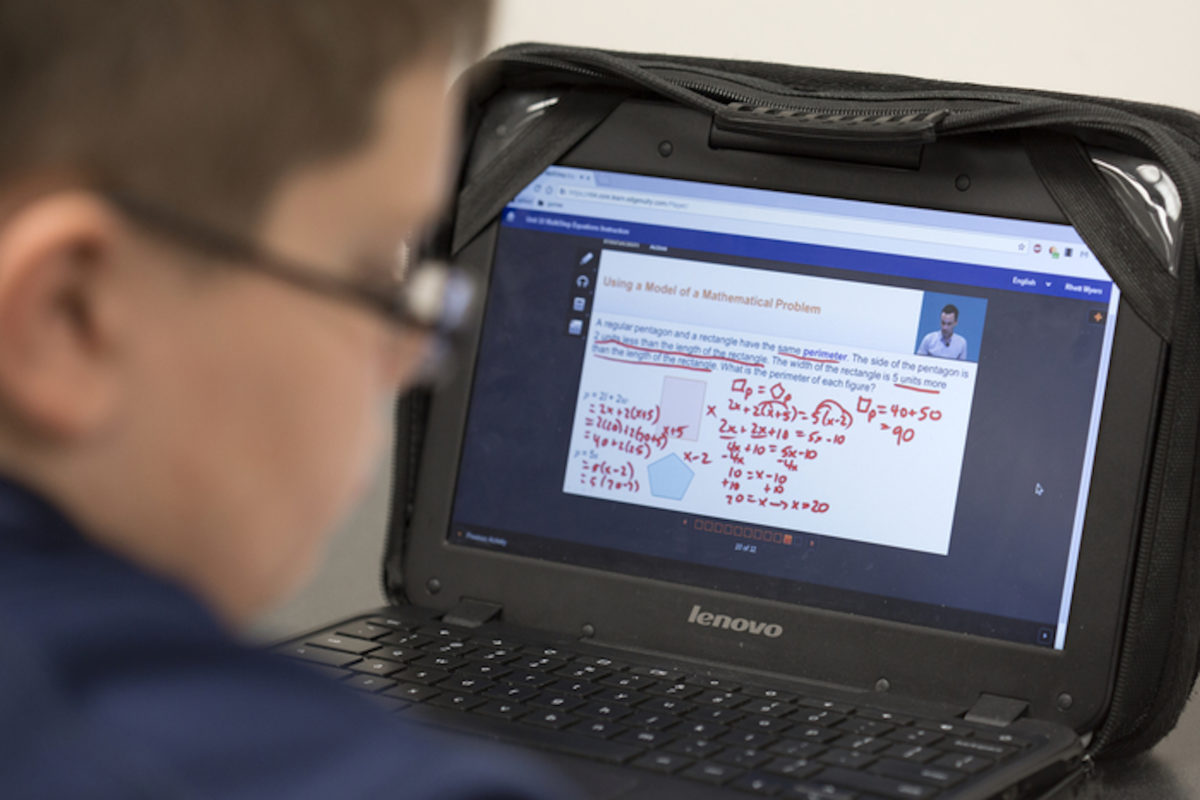
Every few months it seems educators get inundated with stories about the next big thing in classroom technology—a “game changer” set to “revolutionize” teaching and learning. Sound familiar? It should. Education technology, for all its benefits (and there are many), tends to be subject to egregious hype. A lot of money, after all, is to be made and many school districts—eager to demonstrate that their schools are on the “cutting edge”—can make some rather questionable purchasing decisions.
Just recall the 2013 decision by Los Angeles Unified School District to proceed with a $1.3 billion plan to put an iPad loaded with a Pearson curriculum in the hands of every student. Technical glitches and lack of teacher training were just a couple of problems that eventually crippled the initiative.
Educators know better than anyone that healthy skepticism or at least caution about the latest classroom technology will end up serving their students best. It’s a stand that gets teachers branded as resistant to change, a convenient and unhelpful label. It has more to do with what’s best for student learning.
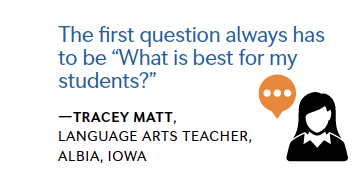 The good news is that the impulse to buy into the latest hype has been curtailed somewhat over the past few years as educators have taken a seat at the table. If you want to try the latest and greatest virtual learning, gamification, personalization, the first question always has to be “What is best for my students?” As Tracey Matt, a language arts teacher in Albia, Iowa, says. “It takes a great teacher to foster independent learners. This must be done with the use of technology on the forefront, but it should not supersede the importance of an instructor.”
The good news is that the impulse to buy into the latest hype has been curtailed somewhat over the past few years as educators have taken a seat at the table. If you want to try the latest and greatest virtual learning, gamification, personalization, the first question always has to be “What is best for my students?” As Tracey Matt, a language arts teacher in Albia, Iowa, says. “It takes a great teacher to foster independent learners. This must be done with the use of technology on the forefront, but it should not supersede the importance of an instructor.”
Technology will continue to advance and more “game-changers” are invariably lurking around the corner. Maybe they can revolutionize the classroom, but it’s the educator who is best suited to determine how and why new tech should be used to best serve students.
Pushing Back Against Privatization
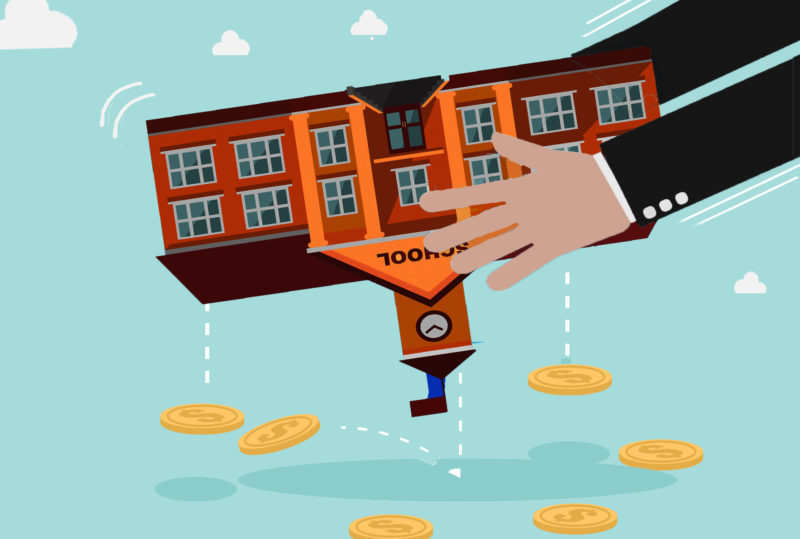
Secretary of Education Betsy DeVos may be privatization’s most visible and stalwart proponent, but school privatization has been a threat to public education for more than 20 years and is financed and championed by a network of corporate interests. Their goal: to use their financial muscle and propaganda to undermine the mission of public schools and position the nation’s students as commodities upon which to draw a sizeable profit.
Still, DeVos’ appointment to lead the nation’s education agenda in 2017 was a huge boost just as charter schools and voucher programs were losing a little steam. (Vouchers have been voted down at the ballot box every time they’ve been attempted through referendum.)
DeVos is a vocal advocate of cutting education spending and freeing up federal dollars to expand charter and voucher programs nationwide. Charter schools have expanded dramatically since their introduction in 1992, and currently serve about 5 percent of the nation’s students.
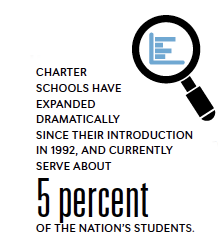 Educators, however, are determined to stop vouchers from taking hold in the way charters have done. Voucher schemes drain hundreds of millions of dollars away from public school students to pay the private school tuition of a select few.
Educators, however, are determined to stop vouchers from taking hold in the way charters have done. Voucher schemes drain hundreds of millions of dollars away from public school students to pay the private school tuition of a select few.
They “are destructive and misguided schemes that use taxpayer dollars to “experiment with our children’s education without any evidence of real, lasting positive results,” says former NEA President Lily Eskelsen García.
Educators and activists are making a huge difference in their states by lobbying lawmakers to reject vouchers (often rebranded by their advocates as “education savings accounts” or “tuition tax credits”).
In 2018, New Hampshire educators led the way in defeating a plan to establish so-called “education savings accounts,” which would have diverted a massive chunk of taxpayer money from public schools to fund the private school education of some students. Private schools would have to accept public funds but provide “no access to financial records, student achievement data, and no say in how the school is run,” says Megan Tuttle, president of NEA-New Hampshire. “The absence of public accountability for voucher funds has contributed to rampant fraud, waste, and abuse in current voucher programs across the country.”
NEA: Vouchers Cost Kids
Voucher proposals have been defeated in other states but their proponents are nothing if not relentless. Which is why, according to David Sciarra, executive director of the Education Law Center, activists must stay alert to the ongoing effort to push school voucher initiatives and to hold them up to public scrutiny.
“There’s a need to be vigilant in every state where governors and key legislators support these bills,” Sciarra says.
Join the fight against school vouchers at vouchers.nea.org
Electing Better Lawmakers

Did you yell at the TV when you heard Betsy DeVos confuse proficiency and growth during her confirmation hearing? Are you disturbed by out-of-touch lawmakers like Arizona’s John Allen, who said teachers work second jobs so they can afford boats and big homes? Do you cringe at the fact that some Kansas lawmakers have tried to skirt the state supreme court’s ruling that they must remedy the woeful underfunding of schools?
The reality is that too few elected officials at the local, state, and federal level have the in-depth knowledge of public education that only comes from working as an educator. And it shows in their policies and their budgets.
As if educating students every school day weren’t enough, it’s also on you to make sure officeholders understand the issues you face in the classroom and how to make progress solving them.
The key is to show up and speak up.
“We have to make our voices heard by the people who are making decisions that affect our classrooms,” says Maryland music teacher Jessica Fitzwater.
 Balvir Singh, a high school math teacher from Burlington, N.J., won a seat on the Burlington County Board of Freeholders in November. Singh, an alum of NEA’s See Educators Run candidate training program, previously served on his local
Balvir Singh, a high school math teacher from Burlington, N.J., won a seat on the Burlington County Board of Freeholders in November. Singh, an alum of NEA’s See Educators Run candidate training program, previously served on his local
school board.
“Elected officials need to understand that it’s not just dollars and cents, students’ entire lives will be impacted by these decisions,” she adds.
That means showing up and sharing your story at school board meetings, lobby days with state lawmakers, and town halls when your members of Congress are back home. Check your state association website and attend your next local association meeting to find out how to get involved.
And if your elected leaders still aren’t listening, throw your support behind people who will.
This November brings a critical opportunity to elect (or re-elect) pro-public education candidates who are not beholden to those who want to privatize education, and who are willing listen to educators and parents.
Educators are reliable voters. But you can inspire others to head to the polls for pro-public ed candidates as well.
Latwala Dixon, a math teacher at Columbia High School in Lake City, Fla., says talking to people about the importance of voting in past election cycles has made her even more passionate about the issues that affect her as an educator and a citizen.
“I tell a lot of people, if you don’t use your right to vote, you will lose it,” Dixon says. Some of the people she speaks with—friends, acquaintances, colleagues—have responded enthusiastically, but others indicate they do not believe their vote makes a difference.
“So what you’re only one vote? Your vote counts,” Dixon says emphatically. “What if all of you ‘only one vote’ people got out there and voted? It could really turn the tide.”
Here’s another “tide turning” way to make sure elected leaders invest in schools—become one yourself! If you’re considering a run or supporting a colleague who is running for office, check out NEA’s candidate training program for members at SeeEducatorsRun.org.

